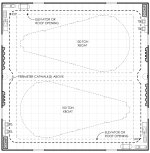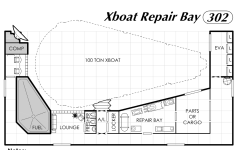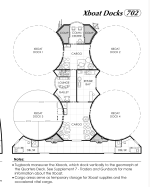Starship Geomorphs has some ideas about XBoat storage and maintenance.
Yes, it does.
But have you ever noticed just how LARGE those plates are?

The full sized decks are 20x20 deck squares in size ... which is 30mx30mx3m = 2700m
3 / 14 = 192.86 tons displacement.
In other words, that
Xboat Repair Bay 302 image that you've provided is ITSELF basically "100 tons of single deck volume" ... and it's supposed to link up with "lots of other sections" to create proper deck plans.
So if you're wanting deck plans for something that is more BCS scale, it's all wonderful, because you've got 2k+ tons worth of starship/space station to play around with and fill up with all kinds of "stuff" for your PCs to wander around (and get lost) in as part of an extremely large structure/craft. But if you're looking for something more akin to an ACS scale of 1k tons or less, a lot of the plates available from Starship Geomorphs are simply "too big" for purpose.
Consider that a 1k starship ought to only have FIVE plates of 20x20 for its interior (less if you want to exclude volume used for fuel tankage).
Don't get me wrong. The symbology used and the visual language detailed by Starship Geomorphs is TOP NOTCH!

I have no complaints about the details going on in the plates and samples, because it's all masterfully done!

In fact, I use them rather routinely as both reference and inspiration for my own deck plan designs!

Where Starship Geomorphs starts running into problems is on the smaller end of scaling, since everything is done in a 20x20 or 20x10 or 10x10 layout (for easy mix 'n' match, of course). That basically means that the smallest sections you can pull from the set are basically ~50 tons (48.2 tons, actually) for a 10x10 deck squares module, which is usually going to be "too big" for most purposes of laying out most of the legacy ACS from LBBs.
For BIG stuff, it's fantastic.
For a 2k ton craft, you would need at least 10 sections of 20x20, with perhaps a 20x10 or a pair of 10x10 stuffed in somewhere to make the tonnages "feel right" for the size the craft ought to be ... but by then, you're not really dealing with an ACS anymore ... you're on the low end of BCS at that point.
Although, to be fair, "small" ACS are going to be necessarily "constrained" in their deck plans in ways that aren't exactly amenable to the usage of Starship Geomorphs anyway ... hence why
liberal quantities of copy/paste clipping into custom deck plans is "the way to go" with using Starship Geomorphs for the creation of ACS deck plans.




